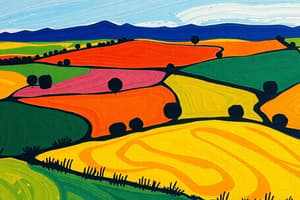Podcast
Questions and Answers
A large farm in a rural area has a mix of dry crop land and a seasonal garden. If independent rates are unavailable, how would the valuation ratio differ between the Jirayat land and Hangami Bagayat land?
A large farm in a rural area has a mix of dry crop land and a seasonal garden. If independent rates are unavailable, how would the valuation ratio differ between the Jirayat land and Hangami Bagayat land?
- The Jirayat land would have a valuation ratio 1.5 times higher than Hangami Bagayat.
- The Hangami Bagayat land would have a valuation ratio twice as high as the Jirayat land.
- Both types of land would have the same valuation ratio.
- The Hangami Bagayat land would have a valuation ratio 1.5 times higher than Jirayat land. (correct)
A farmer cultivates paddy (Kodvai/Dhansheti) on a portion of their land in a rural area where specific land rates are not available. How does the valuation ratio for this paddy cultivation compare to that of dry crop land (Jirayat)?
A farmer cultivates paddy (Kodvai/Dhansheti) on a portion of their land in a rural area where specific land rates are not available. How does the valuation ratio for this paddy cultivation compare to that of dry crop land (Jirayat)?
- The valuation ratio for paddy cultivation is 1.5 times that of Jirayat land.
- The valuation ratio for paddy cultivation is equivalent to that of Jirayat land. (correct)
- The valuation ratio for paddy cultivation is twice that of Jirayat land.
- The valuation ratio for paddy cultivation is half that of Jirayat land.
An agricultural appraiser is tasked with determining land value in a rural region lacking independently specified rates. The land includes areas dedicated to seasonal gardens (Hangami Bagayat) and extended paddy cultivation (Tarpadi/Bagayachi Dhan Sheti). How do their valuation ratios compare?
An agricultural appraiser is tasked with determining land value in a rural region lacking independently specified rates. The land includes areas dedicated to seasonal gardens (Hangami Bagayat) and extended paddy cultivation (Tarpadi/Bagayachi Dhan Sheti). How do their valuation ratios compare?
- Hangami Bagayat land has a valuation ratio 1.5 times higher than Tarpadi/Bagayachi Dhan Sheti land.
- Tarpadi/Bagayachi Dhan Sheti land has a valuation ratio 1.5 times higher than Hangami Bagayat land.
- Both land types have equivalent valuation ratios. (correct)
- Tarpadi/Bagayachi Dhan Sheti has a valuation ratio twice as high as Hangami Bagayat land.
A property in a rural area includes land used for both dry crops (Jirayat) and a perennial garden (Baramahi Bagayat). If no independent rates are specified, what is the relationship between the valuation ratios of these two land types regarding land valuation?
A property in a rural area includes land used for both dry crops (Jirayat) and a perennial garden (Baramahi Bagayat). If no independent rates are specified, what is the relationship between the valuation ratios of these two land types regarding land valuation?
An agricultural investor is evaluating land in a rural area where independent land rates are not specified. The property features areas dedicated to dry crops, seasonal gardens, and fruit orchards. Which land type will attract the highest valuation ratio?
An agricultural investor is evaluating land in a rural area where independent land rates are not specified. The property features areas dedicated to dry crops, seasonal gardens, and fruit orchards. Which land type will attract the highest valuation ratio?
Flashcards
Jirayat Land Ratio
Jirayat Land Ratio
Dry crop land's valuation ratio when agricultural land rates aren't specified in rural areas.
Hangami Bagayat Ratio
Hangami Bagayat Ratio
Seasonal garden land valuation ratio when independent rates are unavailable.
Baramahi Bagayat Ratio
Baramahi Bagayat Ratio
Perennial garden land valuation ratio when no independent rates exist.
Kodvai/Dhansheti Multiplier
Kodvai/Dhansheti Multiplier
Signup and view all the flashcards
Phalbag/Fulbag Ratio
Phalbag/Fulbag Ratio
Signup and view all the flashcards
Study Notes
- The valuation ratios provided are specifically for rural areas.
- These valuation methods are used when independent land rates are not specified.
Valuation Ratios for Different Types of Land
- Jirayat (dry crop) land has a valuation ratio of 1.00.
- Hangami Bagayat (seasonal garden) land has a valuation ratio of 1.50.
- Baramahi Bagayat (perennial garden) land has a valuation ratio of 2.00.
Specific Land Types and Equivalent Ratios
- Kodvai/Dhansheti (paddy cultivation) land uses the same multiplier as Jirayat land.
- Phalbag/Fulbag (fruit/flower gardens) share the same valuation ratio as Baramahi Bagayat land.
- Tarpadi/Bagayachi Dhan Sheti (paddy extension) has a rate equivalent to Hangami Bagayat, which is 1.50.
Highest Multiplier
- Baramahi Bagayat land has the highest multiplier among the categories listed.
Studying That Suits You
Use AI to generate personalized quizzes and flashcards to suit your learning preferences.

